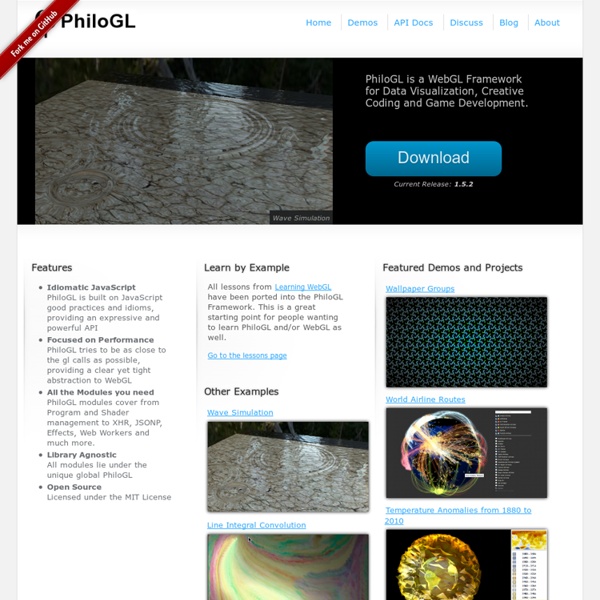



The WebGL Cookbook bost.ocks.org Please find my recent work on Observable. Past Work April 28, 2017A Better Way to Code December 9, 2016Command-Line Cartography March 9, 2016What Makes Software Good? December 28, 2015Introducing d3-scale December 3, 2015Introducing d3-shape November 23, 2015Let’s Make a (D3) Plugin December 27, 2014Mapping Every Path to the N.F.L. December 20, 2014How Each Team Can Make the N.F.L. November 5, 2014The Most Detailed Maps You’ll See From the Midterm Elections November 3, 2014How To Scroll September 19, 2014‘Stop-and-Frisk’ Is All but Gone From New York July 26, 2014Mapping the Spread of Drought Across the U.S. June 26, 2014Visualizing Algorithms June 15, 2014Three Little Circles May 22, 2014Is It Better to Rent or Buy? May 6, 2014Let’s Make a Bubble Map April 22, 2014Who Will Win The Senate? March 7, 2014Let’s Make a Block Feburary 14, 2014Front Row to Fashion Week February 14, 2014Sochi 2014: Interactive Stories January 11, 2014Taking the Battle to the States November 5, 2013Let’s Make a Bar Chart #Examples
Graph Visualization Framework Play WebGL Game d3.js JUNG - Java Universal Network/Graph Framework CopperCube - a 3D editor for Flash and WebGL, Mac OS X and Windows Download Version 5.0.2 WindowsMac free trial version Create first person walkthroughs and games Start demo Includes a terrain editor Start demo Highly detailed, animated scenes are no problem. Lightmaps are integrated, but also dynamic lights are supported Create 3D configurators and model viewers with just a few clicks. Even create first person shooters without programming. Use the powerful scripting API to create sophisticated games. Virtual Reality devices like the Oculus Rift are supported
HTML5 is not ready yet – and will never be (and that is a good thing) – HTML5 Question #1 One of the big questions I repeatedly got at events lately is this: Is HTML5 ready yet? The answer is no, because HTML5 is not a bowl of spaghetti that you know when they are ready by flinging them against the wall. You see, even HTML4.01 or XHTML for that matter was never “ready”. Standard compliance on the web is a means to an end. We used spacer GIFs and for padding and margins before CSS got support, we used tables for layout, we used image maps, we used image replacement, we used HTML generated from JavaScript for different browsers and whatever it took to get the best out of what we had in order to achieve the goal we set ourselves. The goal was always the same: deliver the best possible experience in an unknown, always changing environment. You don’t know what browser in what setting on which operating system with which security settings the end user has. What needs killing is the close-minded limited way we think about web applications. HTML is now a living standard.
Data Visualization Software | Tulip Press Releases - Imagination’s PowerVR Series6 is the first mobile GPU to pass OpenCL 1.2 conformance Bringing highly efficient GPU compute to industry’s leading mobile and embedded GPU London, UK – 31st March, 2014 – Imagination Technologies (IMG.L) announces its PowerVR Series6 Rogue GPU technology is the first mobile GPU to pass OpenCL 1.2 conformance with Khronos The OpenCL 1.2 standard is an open, royalty-free standard for cross-platform, parallel programming of modern processors in a broad range of devices. PowerVR Series6 primarily targets the OpenCL 1.2 EP (Embedded Profile) specification, enabling developers to take full advantage of the rich capabilities in OpenCL 1.2 within the constraints of mobile and embedded form factors. Says Peter McGuinness, director of multimedia technology marketing, Imagination: “Imagination is a long-time member of Khronos and a leading contributor to GPU compute standards efforts such as OpenCL 1.2. GDC 2014 Press Release Summary Developer Sessions at GDC 2014
RockMelt - Not a browser. A WOWser. Main Page/cms/security - WebGL Public Wiki The WebGL API provides a low-level, shader based, 3D graphics API based on OpenGL ES 2.0 that renders directly into an HTML5 Canvas element. As an API for the World Wide Web, WebGL necessarily conforms to the security principles of the web platform, and was designed with security in mind from day one. This white paper provides an overview of some of the security aspects of the WebGL specification and its implementations. Undefined Behavior In the OpenGL ES 2.0 specification, behavior is left undefined in various circumstances, generally in order to achieve the highest performance for native applications on the system. On the web platform, undefined behavior makes it impossible to write strong conformance tests, and may introduce security vulnerabilities. As one concrete example, consider the readPixels API. Out of Range Memory Accesses Access to Uninitialized Memory Shader Validation and Transformation Denial of Service Solutions already exist to this problem on some operating systems.